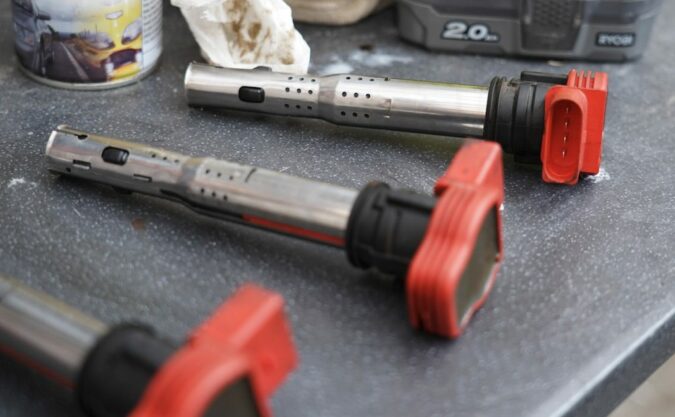Today, ignition control is directly controlled by the engine control module (ECM), the primary computer in the car. But what if the ICM goes bad? What are the symptoms of bad ignition control module?
The spark plugs are ignited by the ignition module. For the engine to function properly, each spark plug must ignite at the precise moment.
When to ignite the spark plugs is decided by the ignition module using information from the crankshaft position sensor or camshaft position sensor.
The base ignition timing of the car is what is meant by this. The ECM receives the sensor signal first on the majority of recent automobiles. The operation of the ignition module is then managed by the ECM using this information.
In some cars, ignition timing is managed by the ignition module below a specific engine RPM and by the ECM above that RPM. In these circumstances, the ignition module may receive the sensor’s signal first.
Ignition Control Module
Many internal combustion engines have a component called an ignition control module that can control the amount of spark production. The ignition module’s principal function is normally to open or close a ground circuit to the ignition coil’s primary winding.
When this happens, the coil is able to produce enough voltage to light a spark plug. The ignition control module normally receives a signal from a sensor inside the distributor to determine when to ground the coil.
In order to shield the internal electronic components, insulating materials are frequently applied to ignition modules, which are frequently found inside or next to the distributor.
The primary winding of the ignition coil in mechanically timed engines is grounded via contact points inside the distributor.
The points open and break the circuit at predetermined intervals when the distributor shaft spins. This results in the primary magnetic field collapsing, allowing the secondary wire to produce a high voltage. With the ignition control module as well as a magnetic or optical sensor inside the distributor, electronic ignitions replace the function of the points.
ICM In Modern Vehicles
Modern automobiles use push-button ignitions that eliminate the need for a distributor key.
In an engine with electronic ignition, the internal sensor transmits input to the ignition control module as the distributor shaft rotates.
The system then operates much like mechanically timed ignitions once the module breaks the ground circuit to the ignition coil primary. With electronic ignitions, the onboard computer may also be able to change the timing to improve fuel economy or reduce exhaust emissions.
One or more transistors or other electronic components that are heat sensitive are often in ignition control modules. Certain modules are on the inside or close to the distributor, where they frequently experience high temperatures.
Although failures are fairly frequent, many control module designs contain some sort of insulating material to guard against heat damage. Typically, the ignition control module failure stops the engine from starting because the main ground circuit is not properly terminated.
Despite the fact that failing ignition control modules often stop working altogether, this causes the engine to shut off and fail to restart.
The failures are often caused by heat. When there is a failure of the ignition control module, a typical failure pattern is for the engine to shut off when it gets hot before restarting and operating normally once it has cooled. Since the module may test well when it is cold, these kinds of problems are frequently challenging to diagnose.
Ignition Control Module Test
The electronic ignition control module serves as the ignition system’s solid-state “On/Off” switch. A sensor inside the distributor sends a signal to the module.
The ignition coil is fired using the signal to supply the spark plugs with energy. The ignition module may be positioned on the side of the engine compartment, on the distributor housing, or inside the distributor.
When a module malfunctions, the engine typically won’t run at all. The simplest of tools are all that is needed to check your ignition module.
Step 1
A used spark plug should be inserted into the end of the plug boot after removing one plug wire from the spark plug. The engine’s metal surface should have the spark plug in it.
Turn the engine on and inspect the old spark plug for a spark. An ignition issue is indicated by no spark on the plug.
Step 2
When the ignition is turned on, check for voltage at the coil positive terminal. Put the multimeter’s red lead on the positive coil terminal. Put the black lead in the negative terminal of the battery.
Turn on the ignition to the run position. The positive terminal of the battery should show voltage on the multimeter. If voltage is absent, the ignition switch or the ignition wire (and the ignition wire to starter solenoid) circuit is at fault.
Step 3
Find the positive (+) wire for the ignition module. Without turning the engine on, turn the key to the “Run” position. With the red lead of the multimeter, pierce the positive wire.
You should measure the battery voltage at the wire. Check for an open circuit between the wire and the ignition switch if the battery voltage is not present.
Step 4
Find the negative (-) wire for the ignition module. With the red lead of the multimeter, pierce the negative wire. You don’t need to disconnect the spark plug wires in order to remove the distributor cover.
Turn the engine over or turn the distributor center shaft by hand. As the engine turns over, keep an eye on the distributor rotor.
The distributor or distributor gears are faulty if the rotor of the distributor cannot turn. Alternating between battery voltage and zero, the multimeter should display voltage.
Step 5
If the multimeter reading does not change as the distributor rotates from battery voltage to zero, the ignition module needs replacing.
Ensure you put the distributor cap in its proper place. Disconnect the battery and ignition module from the multimeter.
Bad Ignition Control Module Symptoms
The ICM needs prompt replacement as it begins to malfunction because it is a crucial component of many ignition systems. The following are typical signs of a malfunctioning ICM and symptoms of bad ignition control module.
Symptoms Of Bad Ignition Control Module #1 – Check Engine Light
If there is a problem with your ignition system, your check engine light will turn on. You can access the problem code by inserting an OBD scan tool into the OBD port on your vehicle.
Examples of trouble codes relating to the ignition include P0300 to P0399. You can always take your car to an auto repair shop for an inspection if you don’t have the right diagnostic instruments.
Symptoms Of Bad Ignition Control Module #2 – Engine Misfires
A misfire in an engine is typically a sign of insufficient combustion. The same holds true for an unreliable engine. If your ICM is faulty, you can also experience problems accelerating.
Symptoms Of Bad Ignition Control Module #3 – Engine Stalling
Stalling may result from a faulty ICM because it prevents the engine from receiving the necessary spark. But keep in mind that stalling might also result from other damaged engine parts.
Therefore, it is best to bring your car to an auto repair shop for an accurate diagnosis.
Symptoms Of Bad Ignition Control Module #4 – Vehicle Won’t Start
Typically, a no-start circumstance occurs when the ICM has failed. As soon as you notice any of the aforementioned signs, take your car in for an inspection to keep it in peak condition.
Consider your options before driving with a damaged ICM because it can eventually harm your catalytic converter and cause other issues.
Ignition Control Module Replacement
When you notice the symptoms of bad ignition control module, you may want to replace it. Your car’s ignition control module manages the ignition spark sequence and ignites the ignition coil. This electronic component, though, is extremely heat-sensitive.
Since the engine compartment is where many car models place their modules, it is common for these parts to eventually fail. But regardless of the kind of your car, follow these instructions to replace the control module.
Step 1
Locate the ignition module after you have parked your car in a secure location.
Step 2
Take a peek under the dashboard. Unplug the wiring harness for the module. Using a Phillips screwdriver or ratchet and socket, remove the mounting bolts. Install the mounting bolts after replacing the old unit with the new module. Connect the wiring loom.
Step 3
Use a Phillips screwdriver or ratchet and socket to open up the hood and take out the distributor cap, but keep the spark plug wires attached to the distributor cap.
The distributor contains some ignition modules. Use a screwdriver or even a ratchet and socket to remove the mounting bolts from the module and unplug the electrical connector. Install the mounting bolts after replacing the outdated module. Put a new distributor cap on.
Step 4
Take a look at the distributor’s side. A few modules connect to the distributor’s outer shell. To avoid messing up the engine timing, mark the exact spot on the engine where the distributor base is so you can reinstall the distributor there.
Use a Phillips screwdriver or ratchet and socket to remove the distributor cap, but leave the spark plug wires in place. Lift the distributor out of the engine compartment after removing the nuts holding it in place.
Install the new module after removing the nuts holding the ignition module in place. Following the matchmark, attach the distributor to the engine and then install the distribution cover.
Step 5
The ignition coil as well as the module assembly should be located. Start with the spark plugs and follow the wires. The coil and module assembly, which may be positioned on the engine’s back, is connected by the wires.
Your automobile may need support with the help of two jack stands after raising the front with a floor jack. Pull off the electrical connectors for the coil assembly from below the engine.
Using a ratchet and socket, remove the mounting bolts for the assembly. Using a ratchet and socket, remove the assembly from the engine and then remove the coils. Install the new ignition module after removing the old one from the base plate.
The engine should have the coils and module assembly installed. Lower the car and attach the electrical connectors.
How Much Does A New Ignition Control Module Cost
Fortunately, changing the ignition control module after noticing the symptoms of bad ignition control module is not a difficult fix. Typically, the price ranges from $50 to $250, which is not too bad.
However, you must be cautious about where you take your car because labor prices might play a significant role. Labor costs typically fall between $70.00 and $90.00.
We urge you to compare offers to replace your ignition control module, but we also caution you to be careful about the repair facility and make sure you’re working with skilled experts.
If you don’t, you might cause the engine serious damage that will cost you thousands of dollars in the future.
If you intend to replace the ignition control module in your car on your own, you must also ensure that you possess the necessary level of mechanical expertise to do the task correctly and without creating other issues.
Remember that the majority of DIY projects don’t work initially, as per what most experts say. Therefore there’s a good chance you will not replace the part properly.
Ignition Control Module Malfunction: Can I Still Drive
It is never a smart idea to continue driving your car when it has a defective ignition control module because of all the potential consequences.
In other cases, you won’t even have a choice since your car won’t even turn on at first; once you experience the signs of a faulty control module, you must take your car to the closest repair facility.
Engine problems including stalling, misfiring, and rough running are exceedingly tricky and risky, especially if you’re on the highway. So, never keep driving a car with a defective control module to avoid endangering your life or the life of the passenger.
Is It Worth Replacing The Ignition Control Module In My Car
The ignition control module is not particularly expensive, as we previously mentioned, and in the majority of cases, it is definitely worth fixing.
However, if your car has other serious issues, you should take a step back and assess the situation.
Calculating the entire cost of repairs is the first stage, which is excellent. List all the things that require repair. For instance, if the thermostat, ignition control module, etc. need replacing.
Also think about adding up any maintenance expenses, such as tire rotation and oil changes.
The next step is to evaluate the total repair cost to the overall value of your car. It is never a good idea to keep fixing this car; instead, you should sell it once you discover that the necessary repairs are approaching 75% of the worth of your car.
Bad Ignition Control Module
Faulty ignition control module causes include:
- Wiring issues – short-circuiting can affect the ignition control module’s capacity to receive and distribute electricity, broken wiring, and loose connections to the spark plugs. This might prevent it from working at all.
- Open circuit spark plug – If the secondary ignition coil side—the side that is in contact with the spark plug—has an open circuit for whatever reason, the ignition coil’s extremely high voltage, as well as magnetic field, must find a way to reach earth. The ignition control module may damage as a result of strong voltage spikes.
- Overheating – The electrical components are often sealed in by a coating of heat-resistant material on the ignition coil. It may still, however, be prone to overheating, particularly if it is worn. An overly hot ignition control module will wear out considerably more quickly.
Electronic Ignition Control Module
An electronic ignition system is a particular kind of ignition system that uses transistors to power electronic circuits. That said it can also show symptoms of bad ignition control module. It is therefore important to watch out for these if you want to ensure that your vehicle is in top working form.
Sensors regulate the transistors to produce electric pulses that create a high-voltage spark that can ignite the lean mixture and result in improved efficiency and fewer emissions.
The entire electronic control of the electronic ignition system.
Since it serves the same function as other types of ignition systems in these vehicles, the electronic ignition system is widely utilized in aviation engines, bikes, motorcycles, and automobiles.
The purpose of an electronic ignition system is still to deliver a high-voltage spark to the spark plug in order to burn or ignite the fuel-air mixture.
As a result of the system’s utilization of sensors, reliability, mileage, and emission levels have all improved.
Electronic Ignition System Components
Below are the parts of an electronic ignition system and their operations:
1. Battery
The battery serves as the ignition system’s power source by supplying the necessary energy when the ignition switch is on. An electrochemical system in the battery type helps to store charges and releases them as needed. Positive and negative connections are present on this battery. While you ground the negative terminal, the positive terminal connects to the key’s ignition switch.
2. The Ignition Switch
The power bottom that turns the system ON and OFF is the ignition switch. Keep in mind that the power comes from the battery when it is on, and the power source is shut off when it is off.
3. Electronic Control Module
As the main current is ON and OFF, this is where the system’s electronic work starts. The element is also the ignition system’s control unit. It is what automatically monitors and regulates the spark’s timing and strength.
The system uses voltage signals from the armature to turn on and off the primary coil. You will find the ECM in the vehicle’s electronic control unit box or separately outside the distributor.
4. Armature
Many people often wonder about the role of this part. The armature produces the system’s magnetic field. The armature in the electronic ignition system is taking the role of contact breaker points in the battery ignition system. This armature comprises of a pickup coil to detect voltage signals, a vacuum advance, and a reluctor with teeth as the moving component.
In order to create and destroy circuits, the electronic module gathers voltage signals from the armature. This establishes the distributor’s timing so that current to the spark plugs reaches them precisely.
5. Ignition Coil
The ignition coil is useful because it contributes to the generation of high voltage for the spark plug. The component, a pulse-type transformer, creates the high-voltage brief fire or spark needed for combustion. The primary winding (outer winding) and secondary winding are the two sets of windings that make up the ignition coil (inner winding).
6. Distributor
The primary winding is the source of the current, which turns on and off thanks to the distributor. In multi-cylinder engines, it helps deliver current to each spark plug.
7. Ignition Plugs
The part that creates the spark within the cylinder uses high voltages from the ignition coil to ignite the fuel-air mixture in the spark plug.
Frequently Asked Questions
Where Is The Ignition Module Located
The module might be found on your car’s ignition system. in the engine compartment, within a distributor installed on a bracket, or. even play a crucial role in the powertrain of the car.
What Does The Ignition Control Module Do
In order to generate the voltage required by the spark plugs to ignite the mixture of air and fuel inside the engine cylinder, the ignition control module regulates the firing of the ignition coil or coils.
How Much Does It Cost To Fix A Misfire
With variable factors at play, you may spend anywhere from $5 to fix a faulty spark plug or cost you as high as $500. How much it will cost will also depend on how many cylinders have misfired.





